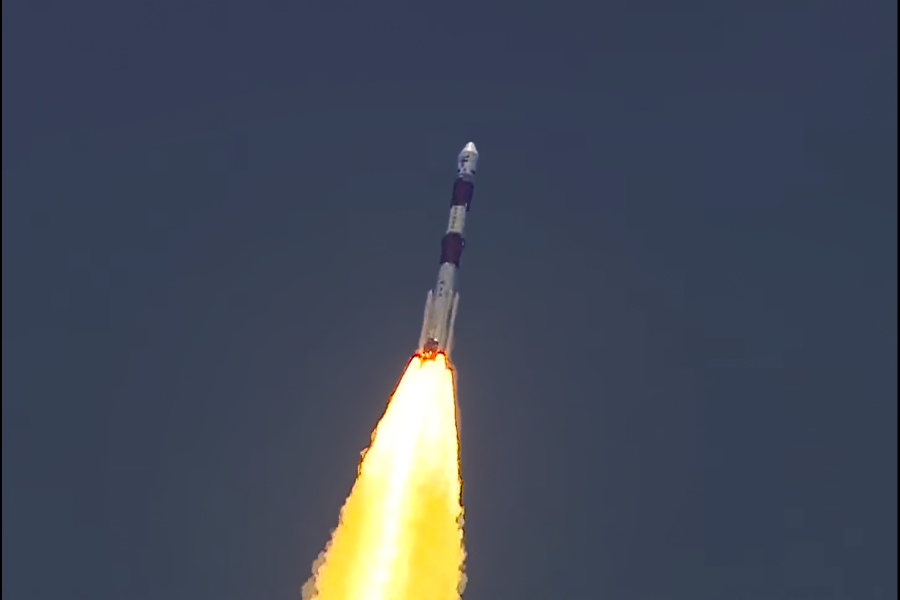An Indian workhorse rocket has ferried into Earth orbit the country’s first space observatory for uninterrupted and unvarnished studies of the Sun from a unique vantage outpost in space occupied at present by only American and European spacecraft.
The Polar Satellite Launch Vehicle (PSLV) successfully injected the spacecraft named Aditya-L1 into its intended 235km-by-19,000km orbit around the Earth after a 63-minute flight, the rocket’s longest and most complex mission yet in the past three decades.
The Indian Space Research Organisation (Isro) said the spacecraft’s solar panels had deployed and Aditya-L1 was generating its own power. In the coming days, Isro ground controllers will initiate orbital manoeuvres to nudge the spacecraft into higher orbits and a trajectory towards its destination — the so-called Lagrange-1 point, about 1.5 million kilometres from the Earth, from where it can continuously observe the Sun.
“After the Earth-bound manoeuvres, Aditya-L1 will start its journey to the L1 point, a long journey of about 125 days,” Isro chairman S. Somanath said after the launch, also applauding PSLV’s flight, which he described as “unique”. The rocket’s fourth stage executed two burn sequences during the flight -- a first that expanded the PSLV’s capabilities.
Aditya-L1 has seven scientific instruments — four to observe the Sun and three to measure the impacts of solar activity in the vicinity of the spacecraft’s L1 parking slot. The instruments are designed to provide fresh insights into solar mechanisms and help generate alerts on space weather changes triggered by solar activity.
Scientists who watched the PSLV launch at the Sriharikota island spaceport on the Andhra Pradesh coast on Saturday said some challenging orbital manoeuvres aimed at injecting the spacecraft around the L1 point lay ahead.
Only the US National Aeronautics and Space Administration (Nasa) and the European Space Agency (ESA) have so far sent spacecraft to the L1 point — Nasa’s Wind spacecraft launched in 1994, the Nasa-ESA Solar and Heliospheric Observatory in 1995, and Nasa’s Advanced Composition Explorer in 1997.
“The orbital dynamics to reach L1 is somewhat tricky,” said Dipankar Banerjee, an astrophysicist and director of the Aryabhatta Research Institute for Observational Sciences, Nainital, who was among the group of scientists that first conceived an Indian space-based solar observatory over 15 years ago.
But, Banerjee said, Isro scientists have successfully achieved precise control of orbital dynamics as evident through the agency's three missions to the moon and one to Mars, each of which had required spacecraft moving at high speeds to slow down to enter desired orbits.
Dibyendu Nandi, a physicist at the Indian Institute of Science Education and Research, Calcutta, who was in Sriharikota on Saturday, said the launch could not have gone any better and Aditya-L1 had been inserted into Earth orbit with high precision.
“The critically challenging step would be the critical insertion into L1 about four months from now, the first such attempt by India,” Nandi told The Telegraph. “If we succeed, it would make Isro the third space agency after Nasa and ESA to have a spacecraft at L1.”
The Sun-observing instruments on Aditya-L1 are intended to provide data on solar magnetic storms and solar flares and help probe a longstanding mystery about the solar corona: why the corona — the Sun’s atmosphere, which is a million degrees Celsius -- is much hotter than the solar surface, which is 6,000 degrees Celsius.
The instruments studying the impacts of solar activity in the vicinity of the L1 point could be used to generate space weather alerts — possible adverse events such as massive bursts of subatomic particles triggered by solar magnetic storms that might have the potential to disrupt satellites’ operations.
Isro centres in Ahmedabad, Thiruvananthapuram and Bangalore developed five of the seven scientific instruments on Aditya-L1, while two were made by the Indian Institute of Astrophysics, Bangalore, and the Inter-University Centre for Astronomy and Astrophysics, Pune.










